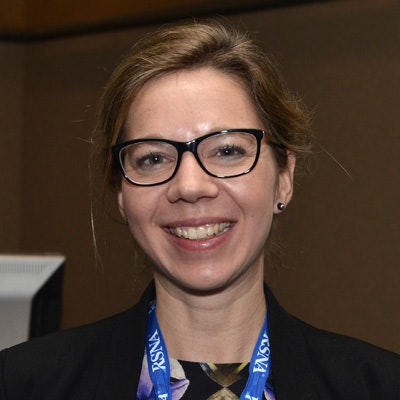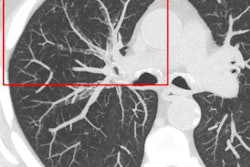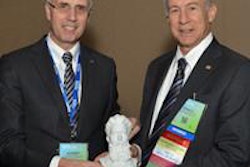
Tulips, Rembrandt, and free cookies feature prominently at the Netherlands Presents booth in the South Building of McCormick Place in Chicago, but during a special session on Monday, delegates found out why the country's high-achieving neuroradiologists are the real star attraction at RSNA 2016.
The Netherlands makes a huge contribution at every RSNA meeting and at this year's congress the country accounts for more than 300 of the 11,000 or so overseas attendees, around 60 presentations, and 11 exhibitors, said RSNA President Dr. Richard Baron in his opening remarks.
 Speakers and moderators during Monday's "Netherlands Presents" session. From the left are Drs. Meike Vernooij, Richard Baron, Herma Holscher, Mark van Buchem, Charles Majoie, and Jeroen Hendrikse.
Speakers and moderators during Monday's "Netherlands Presents" session. From the left are Drs. Meike Vernooij, Richard Baron, Herma Holscher, Mark van Buchem, Charles Majoie, and Jeroen Hendrikse.The Rotterdam Scan Study, which aims to boost the prediction of stroke and dementia based on population imaging, was the first example of Dutch ingenuity and creativity highlighted at the session.
"In this era in which the focus is shifting from cure to prevention, we need to understand better about the pathophysiology of disease and unravel the black box between determinants and outcome," said Dr. Meike Vernooij, PhD, a neuroradiologist, head and neck radiologist, and associate professor in radiology and epidemiology at Erasmus MC in Rotterdam. "That's where medical imaging comes into play because it allows us to look directly at the tissue at risk."
Population studies involve large-scale acquisition and analysis of medical images in population cohorts, and the Rotterdam group's research has shown population imaging plays a central role in etiology and prediction of stroke and dementia, she explained.
 Dr. Meike Vernooij, PhD, from Rotterdam.
Dr. Meike Vernooij, PhD, from Rotterdam.More fine-grained imaging biomarkers increase understanding of disease pathophysiology, and combining high-dimensional data in --omics domains unravel new disease pathways, added Vernooij, who is principal investigator of population imaging of the Rotterdam Study and co-leader of the Rotterdam Scan Study. She was a visiting resident at the department of radiology at Stanford University Medical Center in 2004, and combined her clinical work with a PhD in neuroimaging/neuroepidemiology, for which she received a cum laude award in 2009. She became a research fellow at Erasmus MC in 2011, and her interests include imaging of age-related neurological diseases, cerebral microbleeds, diffusion tensor imaging, and population imaging.
Spotlight on acute ischemic stroke
MRCLEAN, a multicenter randomized clinical trial of endovascular treatment of acute ischemic stroke (AIS), is another model Dutch study. The main objective is to assess the effect of intra-arterial treatment (IAT) on functional outcome after AIS caused by a proximal intracranial arterial occlusion, against a background of best medical management, including intravenous alteplase.
The Netherlands is an ideal location for conducting a randomized clinical trial, being a small, densely packed country (17 million/41.543 km2 [ = 408/km2]) with an excellent infrastructure and track record of intensive collaboration, according to Dr. Charles Majoie, PhD, professor of neuroradiology at the Neurovascular Intervention Center in Amsterdam's Academic Medical Center.
AIS is a major cause of death and disability worldwide, but tremendous progress has occurred in stroke imaging and treatment over the past couple of decades, he noted. For MRCLEAN, the broad inclusion criteria are adult patients with AIS, proximal anterior circulation occlusion (confirmed by CT angiography), internal carotid artery terminus, middle cerebral artery (M1/M2), anterior cerebral artery (A1/A2), and those in whom intra-arterial treatment within six hours from onset is possible.
At the session, Majoie presented results of subgroup analyses related to logistics and CT imaging of patients with AIS due to large vessel occlusions. Out of a total of 196 procedures, 97% involved stent-retrievers.
He noted the key questions to be answered are: How can we identify patients unlikely to benefit? What is the effect of time on subgroup analyses? What's the role of imaging biomarkers? How can we predict functional outcome? By modifying treatment effect, is it possible to identify patients who will not benefit? Is there heterogeneity in treatment effect across subgroups with a specific imaging characteristic?
 Map showing study centers of the MRCLEAN trial. Image courtesy of Dr. Charles Majoie, PhD.
Map showing study centers of the MRCLEAN trial. Image courtesy of Dr. Charles Majoie, PhD.The main imaging findings were published in June (Lancet Neurology). Clear benefits from IAT were shown in some patients, but in others, there were only marginal benefit. CT perfusion (CTP) ischemic core volume predicted functional outcome, but CTP could not identify patients who will not benefit from IAT. Both patients with and without mismatch showed benefit, and there was no significant interaction of CTP-derived parameters with treatment effect.
Majoie acknowledged that he receives institutional research grants from AngioCare, Medtronic, Medac, Penumbra, and Stryker Corporation.
Heart-Brain Connection
Another large-scale multicenter study, called the "Heart-Brain Connection," is evaluating the influence of hemodynamic status on cognitive functioning in the Netherlands. The first results will be published in 2017, said presenter Dr. Mark A. van Buchem, PhD, professor of neuroradiology at the Leiden University Medical Center and head of the Neuroimaging Research Group.
The most likely first scenario is that people with memory loss need to be tested in hemodynamic studies, leading to personalized treatment. The ultimate aim is to unravel the hemodynamic mechanisms that contribute to cognitive loss in old age, and imaging plays a central role in the study, explained van Buchem, whose research interests are MRI techniques, in particular quantitative and functional methodologies, and the diseases of the brain, especially aging and dementia, lupus erythematosus, and migraine.
Heart-brain axis may be a target for limiting age-related cognitive decline, and MRI is a great tool to probe the heart-brain axis and help develop personalized treatment in the future, he said. Interdisciplinary research in this area can make the difference, and radiologists should not be shy in taking the lead because in both clinical work and research, they have a tradition for interdisciplinary work, he continued.
During the session, van Buchem was asked if the study might eventually lead to a screening program or risk-profile screening.
"It's hard to say," he answered. "If we can identify the subpopulation of the elderly who may benefit from this assessment, then who knows?"
Future of 7-tesla MRI
Experiences of high-resolution brain imaging in old age at the Virtual Institute of Seven Tesla Applications (VISTA) were presented by Dr. Jeroen Hendrikse, professor of radiology at Utrecht University Medical Center.
The increased signal-to-noise ratio (SNR) of ultrahigh-field MRI is being used for high-resolution imaging of the macrovasculature, microvasculature, and brain hemodynamics, he said. High-resolution imaging of the macrovasculature includes visualization and characterization of intracranial vessel wall lesions (atherosclerosis, enhancing plaques), while high-resolution imaging of the microvasculature includes visualization of cortical and noncortical microinfarcts and characterization of white matter lesions and lacunar infarcts.
Detailed imaging of brain hemodynamics includes flow velocity and pulsatility quantification of the perforating arteries and functional imaging of cerebral reserve of cortical layers and the cerebral white matter, Hendrikse added.
It's essential to understand the role of high-resolution MRI for diagnosis of macrovascular brain disease, the role of high-resolution MRI for diagnosis of microvascular brain disease, and the role of high-resolution MRI for brain hemodynamics and functioning, he maintained.
"I'm not trying to convince you that you must all go out and buy a 7-tesla machine; I just want to show you what's possible. So it's about translational knowledge," he told RSNA attendees.
Ask yourself what useful details can be obtained about a patient at a higher field strength to help you in clinical practice, he recommended. "It's not about signal to noise but about contrast to noise."
Over the next five years, the main challenge will be to work out exactly how to translate the technology into clinical practice, Hendrikse said. Precision imaging at all field strengths will become the vital factor in the years ahead. For instance, when it comes to imaging the pituitary gland, there tend to be a lot of false positives and false negatives, and with brain tumors, we need to see exactly where the tumors are growing, he continued.
For functional MRI, the promise is it will show changes in individual changes, but a lot of difficulties remain, he said. For group analysis of patients, 3 tesla is just as good as 7 tesla and it avoids the problems with homogeneities.
During the session, companies from the Netherlands were praised for their technological prowess and contributions to medical imaging. Among the Dutch-based exhibitors at RSNA 2016 are Encapson, Forcare Holding, Invest in Holland, Lamboo Medical Mobile, MILabs, Philips Healthcare, Prodrive Technologies, Quantib, ScreenPoint Medical, Sigmascreening, and Surgivision.




















